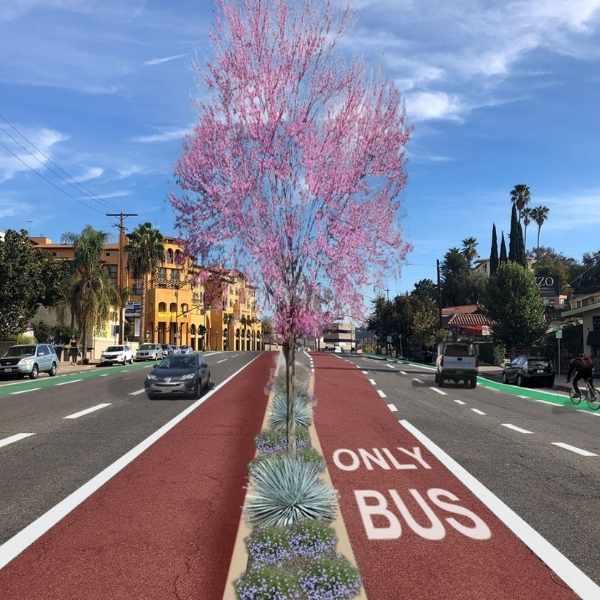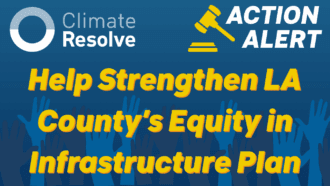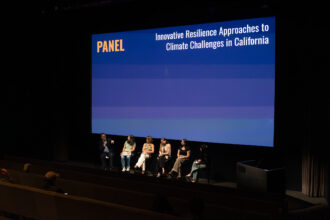It’s cars. Plain and simple. In fact, if you look at every single industry in the State, every single smokestack, they still contribute 7% less to our overall greenhouse gas emissions than personal vehicles. That’s all before we add the additional 4% from oil and gas production.

Vehicle emissions are a huge problem, but that also means that addressing them is a huge solution. In fact, UC Berkeley estimates that reducing vehicle miles traveled (i.e. how much we drive) in the City of Los Angeles could mean a reduction of 821,029 Metric Tons of CO2 by 2030.

We are not going to reach our climate goals and avoid the worst impacts of climate change without sustained and substantial investment in public transportation and active transportation infrastructure (e.g. safe streets for pedestrians and bike lanes). For that reason, building Bus Rapid Transit (BRT) is one of the most important climate solutions available in Los Angeles.
The North Hollywood to Pasadena BRT line is one of those projects. Specifically, configurations like those proposed by the Eagle Rock community in the Beautiful Boulevard proposal show promise to reduce emissions, clean the air, increase the ridership of the bus line, and all while providing aid local businesses. Let’s examine a few crucial components.
Dedicated travel lanes for buses
Travel time and frequency of buses is one of the fundamental components that drives ridership in BRT, which we greatly need to reduce our vehicle trips in Los Angeles. The configurations proposed in the Beautiful Boulevard proposal maintain dedicated bus lanes, which are crucial to reliability, headways and travel time. Maintaining medians along with bus lanes will greatly improve rider safety, as medians that provide pedestrian refuges are shown to reduce collisions involving pedestrians by 39-46%.
Expanding Urban Greenery
Eagle Rock currently sees an average of just two days a year with highs above 99°F. That average could potentially skyrocket to 15 days a year by 2035, as well as a 5 degree annual average temperature increase (see cal-adapt local snapshot tool). On top of heat, climate change is also creating dramatic swings in precipitation between drought and extreme precipitation.
The new sidewalk and median trees in the Beautiful Boulevard proposal will be incredibly important in helping Eagle Rock adapt to climate change, as evapotranspiration and shading provided by trees can cool surface temperatures up to 45°F and the additional planted medians will aid in infiltrating water during extreme precipitation events.
Maintaining and improving bike lanes
Almost 50% of trips in Los Angeles are under 3 miles. That means being able to get on a bike or a scooter and safely arrive at your destination has a huge impact on how many vehicle trips are being made. Along the proposed sections of Colorado Boulevard, there were two reports of cyclists being hit in just four years (LA DOT SWITRS Data 2012-2016), which is concerning, given that 10% of all crashes are reported to the police. The Beautiful Boulevard proposal seeks to maintain bike lanes in one section, and have fully separated bike lanes in others, which would greatly improve safety.
Benefits for local businesses
Pedestrian and bicycle improvements are a huge boon for local businesses. A recent international study of major cities found that the introduction of bike lanes can increase economic activity anywhere from 10-56%, and the benefits are particularly strong for food and drink establishments such as those that make up much of Colorado Boulevard.
In addition to increasing a business’s customer base, these improvements would be particularly helpful to workers in Eagle Rock, a neighborhood where 91.7% of workers commute in for work, many from Pasadena and Burbank, according to U.S. Census data. According to Eagle Rock’s local business owners, a large percentage of employees rely on public transportation to get to work. Improving the convenience and reliability of public transit can be one way to help attract and retain employees amidst a competitive job market. Employees and employers would both greatly benefit from more reliable and faster transportation to the area.
The Bottom Line
Between wildfires, extreme heat and drought, climate change is already hitting Los Angeles hard. Without action, these impacts will only grow. Projects like the Beautiful Boulevard proposal are absolutely crucial in addressing the climate crisis. By both reducing driving-related emissions and adapting our communities to the impacts of climate change, we can build a brighter LA, one neighborhood at a time.




